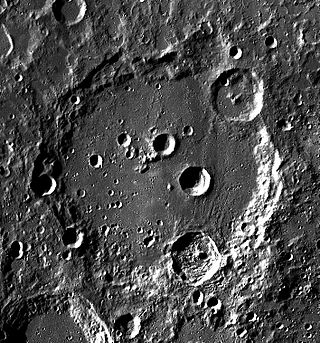- Clavius (crater)
-
Clavius (crater) 
Clavius on the moon. NASA photo.Coordinates 58°24′S 14°24′W / 58.4°S 14.4°WCoordinates: 58°24′S 14°24′W / 58.4°S 14.4°W Diameter 225 km Depth 3.5 km Colongitude 15° at sunrise Eponym Christoph Klau Clavius is one of the largest crater formations on the Moon, and it is the third largest crater on the visible near side. It is located in the rugged southern highlands of the Moon, to the south of the prominent ray crater Tycho.
Contents
Description
Due to the location of the crater toward the southern limb, the crater appears oblong due to foreshortening. Because of its great size, Clavius can be detected with the unaided eye. It appears as a prominent notch in the terminator about 1-2 days after the Moon reaches first quarter. The crater is one of the older formations on the lunar surface and was likely formed during the Nectarian period about 4 billion years ago. Despite its age, however, the crater is relatively well-preserved. It has a relatively low outer wall in comparison to their size, and it is heavily worn and pock-marked by craterlets. The rim does not significantly overlook the surrounding terrain, making this a "walled depression". The inner surface of the rim is hilly, notched, and varies in width, with the steepest portion in the south end. Overall the rim has been observed to have a somewhat polygonal outline.
Crater floor
The floor of the crater forms a convex plain that is marked by some interesting crater impacts. The most notable of these is a curving chain of craters that begin with Rutherfurd in the south, then arc across the floor in a counterclockwise direction forming a sequence of ever diminishing diameters. From largest to smallest, these craters are designated Clavius D, C, N, J, and JA. This sequence of diminishing craters has proved a useful tool for amateur astronomers who want to test the resolution of their small telescopes.
The crater floor retains a diminished remnant of a central massif, which lies between Clavius C and N. The relative smoothness of the floor and the low size of the central peaks may indicate that the crater surface was formed some time after the original impact.
Nearby craters
Notable nearby craters include Scheiner to the west; Blancanus to the southwest; Maginus in the northeast, and Longomontanus to the northwest. The crater Rutherfurd lies entirely within the southeastern rim, while Porter overlays the northeast wall. The smaller crater Clavius L lies across the western rim, and Clavius K breaks through the west-southwest rim.
Satellite craters
By convention these features are identified on lunar maps by placing the letter on the side of the crater mid-point that is closest to Clavius.
Clavius Latitude Longitude Diameter C 57.7° S 14.2° W 21 km D 58.8° S 12.4° W 28 km E 51.5° S 12.6° W 16 km F 55.4° S 21.9° W 7 km G 52.0° S 13.9° W 17 km H 51.9° S 15.8° W 34 km J 58.1° S 18.1° W 12 km K 60.4° S 19.8° W 20 km L 58.7° S 21.2° W 24 km M 54.8° S 11.9° W 44 km N 57.5° S 16.5° W 13 km O 56.8° S 16.4° W 4 km P 57.0° S 7.7° W 10 km R 53.1° S 15.4° W 7 km T 60.4° S 14.9° W 9 km W 55.8° S 16.0° W 6 km X 60.0° S 17.6° W 7 km Y 57.8° S 16.0° W 7 km See also
- Clavius Base, the site of a lunar administrative facility in the movie 2001: A Space Odyssey.
References
- Wood, Chuck (2007-08-06). "Smooth Stuff". Lunar Photo of the Day. http://www.lpod.org/?m=20070806. Retrieved 2007-08-06.
- Andersson, L. E.; Whitaker, E. A., (1982). NASA Catalogue of Lunar Nomenclature. NASA RP-1097.
- Blue, Jennifer (July 25, 2007). "Gazetteer of Planetary Nomenclature". USGS. http://planetarynames.wr.usgs.gov/. Retrieved 2007-08-05.
- Bussey, B.; Spudis, P. (2004). The Clementine Atlas of the Moon. New York: Cambridge University Press. ISBN 0-521-81528-2.
- Cocks, Elijah E.; Cocks, Josiah C. (1995). Who's Who on the Moon: A Biographical Dictionary of Lunar Nomenclature. Tudor Publishers. ISBN 0-936389-27-3.
- McDowell, Jonathan (July 15, 2007). "Lunar Nomenclature". Jonathan's Space Report. http://host.planet4589.org/astro/lunar/. Retrieved 2007-10-24.
- Menzel, D. H.; Minnaert, M.; Levin, B.; Dollfus, A.; Bell, B. (1971). "Report on Lunar Nomenclature by the Working Group of Commission 17 of the IAU". Space Science Reviews 12 (2): 136–186. Bibcode 1971SSRv...12..136M. doi:10.1007/BF00171763.
- Moore, Patrick (2001). On the Moon. Sterling Publishing Co. ISBN 0-304-35469-4.
- Price, Fred W. (1988). The Moon Observer's Handbook. Cambridge University Press. ISBN 0-521-33500-0.
- Rükl, Antonín (1990). Atlas of the Moon. Kalmbach Books. ISBN 0-913135-17-8.
- Webb, Rev. T. W. (1962). Celestial Objects for Common Telescopes (6th revision ed.). Dover. ISBN 0-486-20917-2.
- Whitaker, Ewen A. (1999). Mapping and Naming the Moon. Cambridge University Press. ISBN 0-521-62248-4.
- Wlasuk, Peter T. (2000). Observing the Moon. Springer. ISBN 1-85233-193-3.
Categories:- LQ26 quadrangle
- Impact craters on the Moon
Wikimedia Foundation. 2010.
